This humorous, illustrated guide explores the darker side of avian behavior, revealing quirky, aggressive, and mentally unstable bird species through witty vignettes and vibrant visuals․
Understanding the Concept of Troubled Birds
Troubled birds are avian species exhibiting abnormal or disturbing behaviors, such as aggression, violence, or psychological instability․ This concept is central to the guide, which humorously yet informatively explores these birds’ quirky and often alarming traits․ By blending witty narratives with vibrant illustrations, the guide defines and categorizes troubled birds, offering insights into their behavior and characteristics․ It serves as both an educational tool and an entertaining read, helping enthusiasts recognize and understand these unusual birds․ The guide emphasizes the importance of awareness, allowing readers to identify and avoid such species, while also appreciating their unique, albeit troubled, nature․
Why This Guide is Essential for Bird Enthusiasts
This guide is a must-have for bird enthusiasts, offering a unique blend of humor, vibrant visuals, and practical insights․ It enables readers to quickly identify psychotic, violent, or mentally unstable bird species, providing a fascinating look into the darker side of avian behavior․ By focusing on North American birds, the guide serves as an indispensable tool for anyone seeking to understand and avoid disturbed species․ Its non-technical language makes it accessible to all, while its witty vignettes and eye-catching illustrations ensure an engaging read․ Whether for safety, knowledge, or entertainment, this guide is a valuable resource for bird lovers and enthusiasts alike․
Understanding Troubled Birds
This guide humorously explores the darker side of avian behavior, identifying psychotic, violent, or mentally unstable bird species through vibrant visuals and witty descriptions․
Defining Troubled Bird Behavior
Troubled bird behavior refers to abnormal or erratic actions in birds, such as aggression, erratic flight patterns, or repetitive, compulsive behaviors․ These behaviors often stem from psychological distress, environmental factors, or social instability․ The guide highlights species like irate hummingbirds and judgmental parrots, showcasing their unusual traits․
Identifying these behaviors requires observation of deviations from normal avian conduct, such as excessive vocalization or avoidance of social interactions․ The guide humorously categorizes these behaviors, making it accessible for enthusiasts to recognize and understand troubled birds․
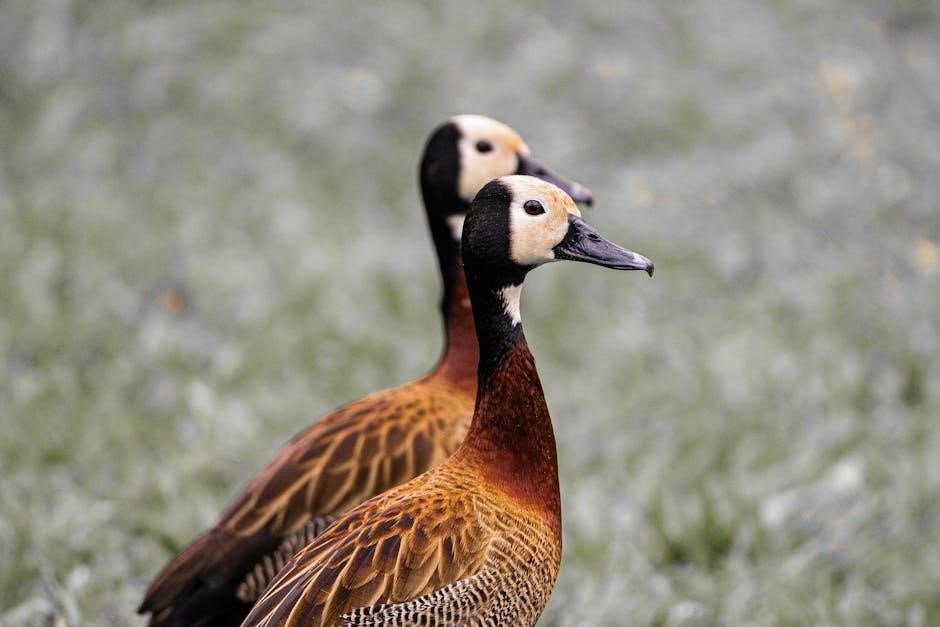
The Science Behind Avian Psychological Distress
Avian psychological distress arises from a combination of environmental stressors, social dynamics, and genetic predispositions․ Research indicates that birds, like mammals, can experience mental health challenges due to factors such as habitat disruption, isolation, or trauma․ The guide highlights how these stressors can lead to abnormal behaviors like aggression, excessive vocalization, or repetitive actions․ Ornithologists suggest that troubled birds exhibit neurological responses similar to humans under stress, including heightened cortisol levels and altered brain activity․ Understanding these underlying causes helps in identifying and addressing the root of their distress, offering insights into how to support their well-being effectively․
Common Signs of a Troubled Bird
Troubled birds often exhibit abnormal behaviors that signal psychological distress․ Aggressive actions, such as biting or excessive vocalization, are key indicators․ feather plucking, pacing, or repetitive movements may also suggest mental instability․ Some birds display heightened anxiety, avoiding social interactions or showing fear of their environment․ In severe cases, they may become lethargic or refuse to eat․ These behaviors deviate from normal avian conduct and can be early warnings of deeper emotional issues․ Recognizing these signs is crucial for providing timely support and ensuring the bird’s well-being․ The guide offers insights into identifying these traits, helping enthusiasts and caregivers address the problem effectively․
Identifying Troubled Bird Species
This guide offers a humorous yet insightful look at recognizing birds with psychotic, aggressive, or unstable traits, helping enthusiasts quickly identify troubled species through vivid descriptions and illustrations․
Key Characteristics of Psychotic Bird Behavior
Psychotic bird behavior is marked by extreme aggression, erratic actions, and unusual vocalizations․ These birds often exhibit irrational fear or hostility toward humans and other animals․
Physical traits include disheveled plumage, abnormal posturing, and relentless pacing․ Some species, like irate hummingbirds, display territorial rage, while others, such as judgmental parrots, mimic disturbing sounds․
The guide highlights traits like murder, assault, and quirky behaviors, offering vivid descriptions to help enthusiasts recognize these troubled species․
Through humorous yet insightful vignettes, the guide transforms avian psychology into an engaging and unforgettable read․
Violent or Aggressive Bird Species
Violent or aggressive bird species often exhibit extreme territoriality or unprovoked attacks․
Examples include irate hummingbirds defending feeding grounds and assaultive parrots mimicking aggressive human behavior․
The guide highlights species prone to attack humans or other birds, such as murderously inclined crows or dive-bombing gulls․
These birds are often unpredictable, with traits like relentless pursuit or loud, threatening calls․
The guide humorously categorizes these species, offering vivid descriptions and encounters․
By understanding their behavior, enthusiasts can better navigate interactions and avoid dangerous situations․
This section is a must-read for anyone encountering these feathered foes in North America․
Mentally Unstable Birds and Their Traits
Mentally unstable birds often exhibit quirky, irrational behaviors that set them apart from their peers․
These traits may include erratic flight patterns, obsessive feather plucking, or persistent vocalizations․
The guide highlights species like judgmental parrots and neurotic woodpeckers, known for their unusual antics․
Mental instability in birds can manifest as excessive aggression, fearlessness, or even self-destructive habits․
Some species, such as the perpetually stressed sparrow, display chronic anxiety, while others, like the delusional owl, exhibit illogical behaviors․
These traits are often linked to environmental stressors or genetic predispositions․
The guide humorously portrays these birds, offering insights into their peculiar behaviors and how they navigate their troubled lives․
The Importance of Recognizing Troubled Birds
Recognizing troubled birds is crucial for safety and conservation, as their erratic behavior can pose risks to humans and ecosystems․ Understanding these birds ensures awareness and protection․
Why Understanding Troubled Birds Matters
Understanding troubled birds matters for both safety and conservation․ By identifying erratic behavior, enthusiasts can avoid dangerous encounters and better protect these unique species․ The guide offers insights into quirky, aggressive, and unstable birds, blending humor with expertise․ It serves as a vital resource for anyone fascinated by avian behavior, providing a unique perspective on the darker side of birds․ This knowledge not only enhances appreciation for wildlife but also encourages responsible interaction, making it a must-have for bird lovers and researchers alike․
Protecting Yourself and Others from Aggressive Birds
Protecting yourself and others from aggressive birds is crucial, especially when dealing with mentally unstable or violent species․ The guide provides practical tips on identifying warning signs, such as erratic behavior or loud vocalizations, to avoid dangerous encounters․ By understanding these traits, enthusiasts can maintain a safe distance and recognize when a bird may pose a threat․ Additionally, the guide offers advice on safely approaching or avoiding troubled birds, ensuring both human and avian well-being․ This knowledge is essential for bird lovers and researchers, helping them navigate interactions with caution and respect for these unique creatures․
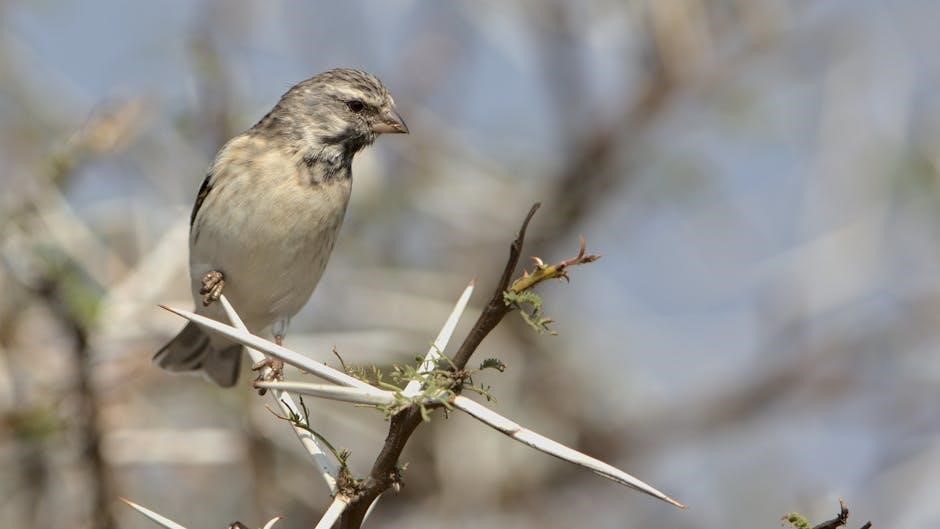
Causes of Troubled Behavior in Birds
Environmental factors, psychological trauma, and social dynamics are key contributors to troubled bird behavior․ These elements often lead to aggression or mental instability in avian species․
Environmental Factors Leading to Distress
Environmental factors significantly contribute to troubled bird behavior․ Habitat loss, climate change, and pollution disrupt natural ecosystems, causing stress and altering bird behavior․ Deforestation reduces nesting and foraging areas, while climate change affects food availability, leading to aggression․ Pollution exposes birds to toxins, impairing their health and mental stability․ These environmental stresses often result in abnormal behaviors, such as increased aggression or erratic nesting patterns․ Understanding these factors is crucial for addressing the root causes of avian distress and promoting healthier bird populations․ By mitigating environmental impacts, we can help reduce the prevalence of troubled bird behavior in various species․

Psychological Trauma in Birds
Psychological trauma in birds can stem from physical injuries, social isolation, or exposure to harsh environmental conditions․ These experiences often lead to behavioral changes, such as increased anxiety, fear, or aggression․ For instance, birds subjected to prolonged stress may exhibit erratic flight patterns or vocalizations․ In some cases, trauma can result in heightened aggression, as seen in species like irate hummingbirds or judgmental parrots․ Recognizing these signs is crucial for understanding and addressing the mental distress of birds, helping to provide appropriate care and support․ This guide highlights such behaviors, offering insights into the psychological well-being of troubled birds and ways to mitigate their suffering․
Social Dynamics and Their Impact on Bird Behavior
Social dynamics play a significant role in shaping the behavior of troubled birds․ In many species, hierarchical structures and dominance behaviors can lead to stress and aggression․ For example, dominant birds may bully others, causing psychological distress and erratic behavior․ Additionally, social isolation or displacement from a flock can exacerbate mental instability in birds․ The guide highlights how these social interactions influence avian behavior, offering insights into how birds communicate and establish order within their groups․ By understanding these dynamics, bird enthusiasts can better recognize signs of social-related distress and take steps to create a more stable environment for troubled birds․ This knowledge is essential for fostering healthier bird communities․
Regional Focus on Troubled Birds
The guide highlights troubled bird species across North America, Europe, and Asia, providing insights into their behaviors and habitats for enthusiasts to locate or avoid them effectively․
Troubled Birds of North America
The guide focuses on North America, detailing species like the irate hummingbird and judgmental parrot, known for their quirky and aggressive behaviors․ With vibrant illustrations, it highlights where to find or avoid these disturbed birds, offering a mix of humor and practical advice․ Readers discover tales of murder, assault, and unusual antics, all while learning to identify psychotic, violent, or mentally unstable birds․ The book serves as both an entertaining read and a useful tool for bird enthusiasts, providing insights into the darker side of avian life across the continent․ Its compact format makes it easy to carry, ensuring enthusiasts can quickly recognize troubled birds in their natural habitats․
European Species with Disturbed Behavior
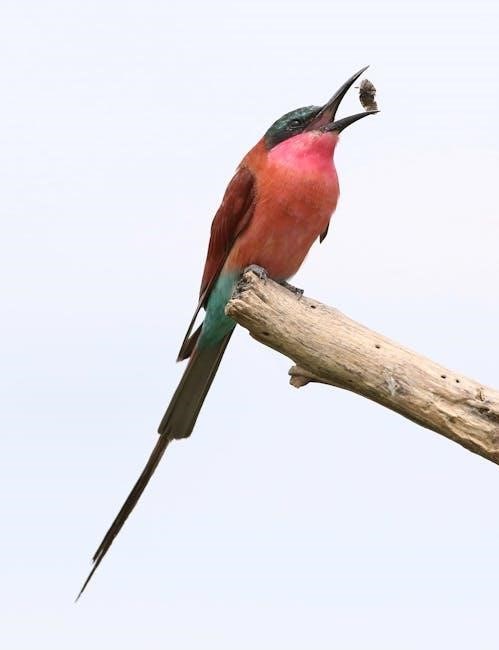
While primarily focused on North American birds, the guide also touches on European species exhibiting unusual behavior․ From aggressive waterfowl to moody corvids, these birds showcase quirky traits that set them apart․ The guide’s humor shines through as it describes their eccentricities, blending wit with insight․ Vibrant illustrations bring these troubled birds to life, offering a visual guide to their distinctive behaviors․ Whether it’s a territorial goose or a brooding raven, the guide provides a lighthearted yet informative look at Europe’s most disturbed avian inhabitants․ This section is a must-read for anyone curious about the darker side of bird behavior across the continent․
Asian Birds Exhibiting Unusual Behavior
While the guide primarily focuses on North American birds, it also highlights intriguing cases of Asian species with peculiar behaviors․ From the territorial displays of certain hornbill species to the enigmatic calls of the lesser-known nightjars, these birds exhibit traits that defy typical avian norms․ The guide humorously explores their eccentricities, blending observational humor with factual insights․ Though not as extensively covered as their North American counterparts, these Asian birds add a unique dimension to the guide’s exploration of troubled behavior․ Their stories, while less documented, provide a fascinating glimpse into the diverse and often quirky world of avian psychology across the continent․

Expert Insights and Case Studies
Ornithologists share fascinating insights into troubled birds, highlighting real-life examples of psychotic behavior and offering expert perspectives on avian psychological distress․
Interviews with Ornithologists on Troubled Birds
The guide features interviews with leading ornithologists, offering deeper insights into troubled birds․ Experts share real-life examples of psychotic behavior, such as the “Irate Hummingbird” and “Judgmental Parrot․” These interviews reveal the science behind avian distress, blending dark humor with factual analysis․ Ornithologists explain how environmental factors and psychological trauma contribute to unstable behavior, providing a unique perspective on these birds’ lives․ The guide also highlights notable case studies, such as aggressive parrots and mentally unstable songbirds, making it both entertaining and educational․ By combining expert opinions with vivid storytelling, the guide sheds light on the fascinating yet lesser-known world of troubled birds, encouraging further exploration and conservation efforts․
Notable Cases of Psychotic Bird Behavior
The guide highlights remarkable cases of psychotic bird behavior, such as the “Irate Hummingbird” and the “Murderous Mourning Dove․” These examples showcase extreme aggression and erratic actions, often linked to environmental stress or psychological trauma․ One notable case involves a parrot exhibiting repetitive, self-destructive behaviors, while another details a songbird attacking its own reflection obsessively․ These stories, supported by vibrant illustrations, provide a fascinating yet unsettling look into avian mental health․ By exploring these unusual behaviors, the guide offers a unique perspective on the complexities of bird psychology, blending humor with scientific observation to engage readers and spark curiosity about these troubled creatures․
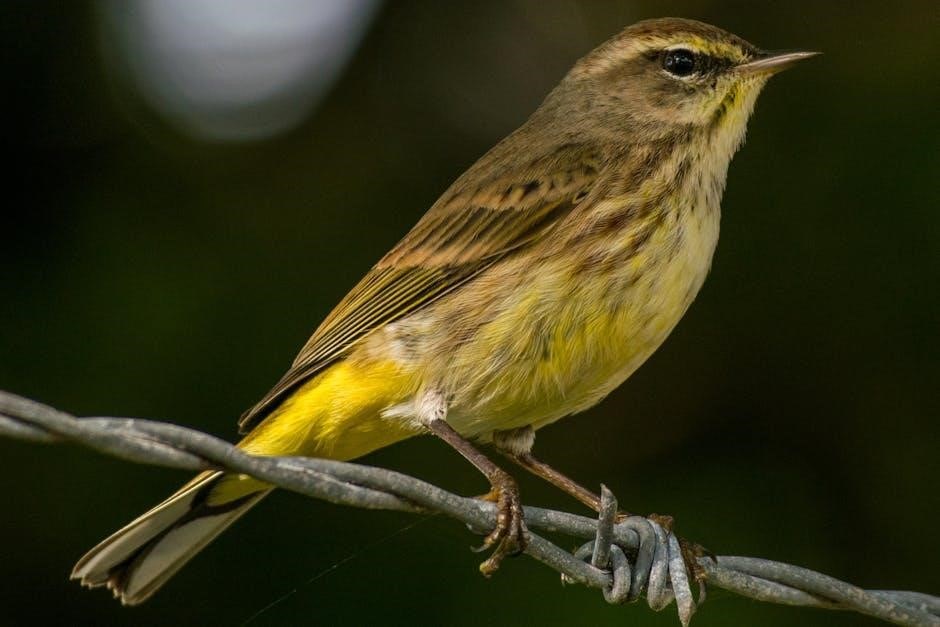
Practical Advice for Bird Enthusiasts
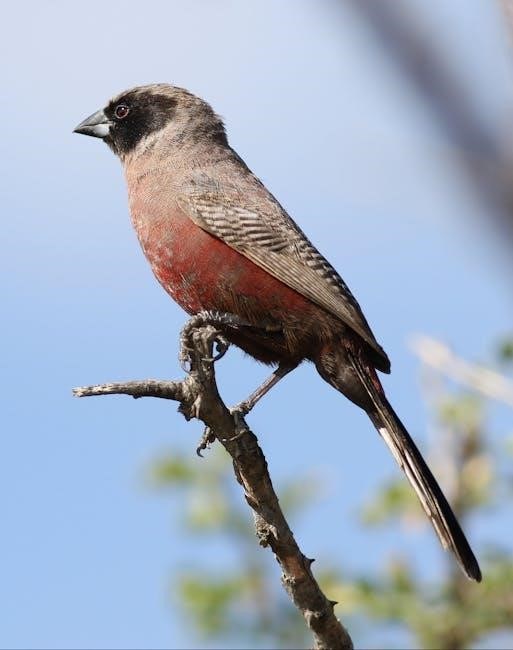
Learn how to safely approach troubled birds, calm agitated species, and recognize when professional intervention is necessary for their well-being and your safety․
How to Safely Approach a Troubled Bird
Approaching a troubled bird requires caution and understanding․ Start by assessing the bird’s environment and behavior to gauge its stress levels․ Move slowly and calmly, avoiding sudden movements that might provoke aggression․ Maintain a safe distance to prevent triggering defensive reactions․ Avoid direct eye contact, as this can be perceived as a challenge․ Use protective gear like gloves or a barrier if necessary․ Do not attempt to feed or touch the bird, as this may escalate its agitation․ If the bird appears overly aggressive or unpredictable, consider seeking professional assistance from a wildlife expert or local animal control․ Prioritize both human and avian safety in all interactions․
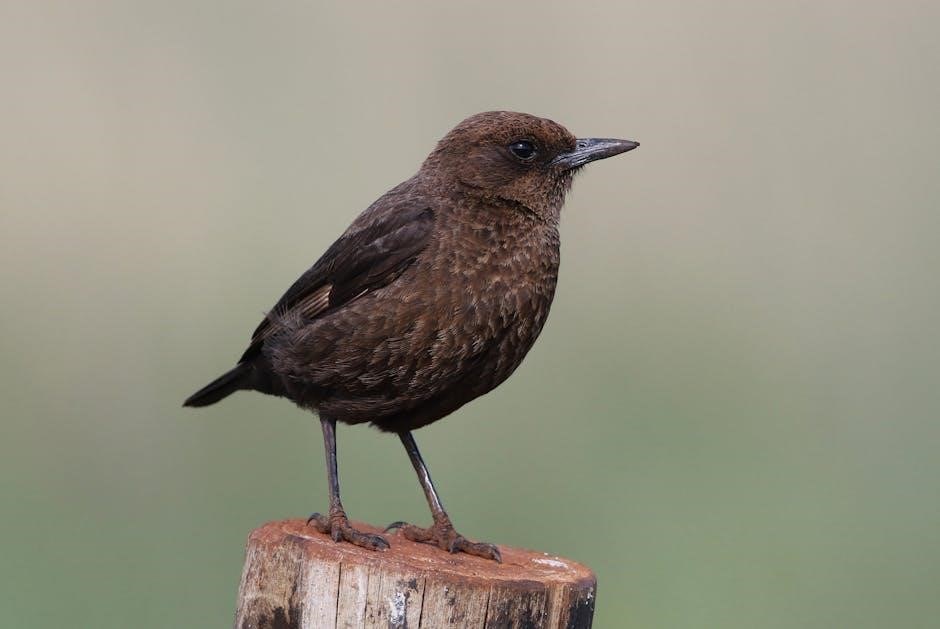
Techniques to Calm Agitated Birds
Calm an agitated bird by first identifying signs of distress, such as rapid breathing or feather ruffling․ Use a cover or towel to gently block its view, reducing visual stimulation․ Minimize noise and move slowly to create a soothing environment․ Provide a safe, enclosed space to help the bird feel secure․ Avoid direct interaction until it appears relaxed․ Offering water or a familiar food source can also aid in calming․ If the bird remains agitated, consider using pheromone products designed to reduce avian stress․ Patience is key, as rebuilding trust takes time․ Always prioritize the bird’s well-being and seek professional help if necessary․
When to Seek Professional Help
Recognizing when a bird’s behavior exceeds normal distress is crucial․ Seek professional help if the bird exhibits severe aggression, self-mutilation, or persistent distress unresponsive to calming techniques․ Consult a certified avian specialist or veterinarian experienced in behavioral issues․ They can provide tailored strategies and medical interventions to address underlying causes․ Professional help is also essential if the bird’s behavior poses a risk to itself or others․ Experts can offer guidance on rehabilitation and safe handling practices․ Don’t hesitate to reach out when the situation is beyond your capacity to manage effectively, ensuring the bird receives the care it needs for recovery and well-being․
The guide to troubled birds offers a unique perspective on avian behavior, blending humor with insight․ It helps enthusiasts recognize and manage interactions with disturbed species, providing practical advice for bird lovers and enthusiasts alike, making it a must-have for anyone passionate about understanding these fascinating creatures․
Final Thoughts on Troubled Birds
The Mincing Mockingbird Guide to Troubled Birds offers a unique blend of humor and insight into the fascinating world of avian behavior․ By highlighting quirky, aggressive, and mentally unstable bird species, the guide provides bird enthusiasts with a fresh perspective on the complexities of bird psychology․ Its vibrant illustrations and witty vignettes make it an engaging read, while its practical advice ensures that readers can safely navigate encounters with disturbed birds․ Whether you’re a seasoned ornithologist or a casual birdwatcher, this guide is an invaluable resource that combines entertainment with education, making it a must-have for anyone intrigued by the darker side of bird behavior․
Encouragement to Continue Learning
Exploring the fascinating world of troubled birds is a journey that combines humor, curiosity, and a deeper appreciation for avian behavior․ The Mincing Mockingbird Guide to Troubled Birds serves as a delightful starting point, offering insights into the quirky and often darker side of bird psychology․ By embracing this guide, readers are encouraged to continue their learning journey, seeking out more resources, such as recommended books and online communities, to expand their knowledge․ The blend of vibrant illustrations and witty storytelling makes the subject accessible and entertaining, inspiring enthusiasts to explore further and appreciate the complexities of bird behavior in a whole new light․
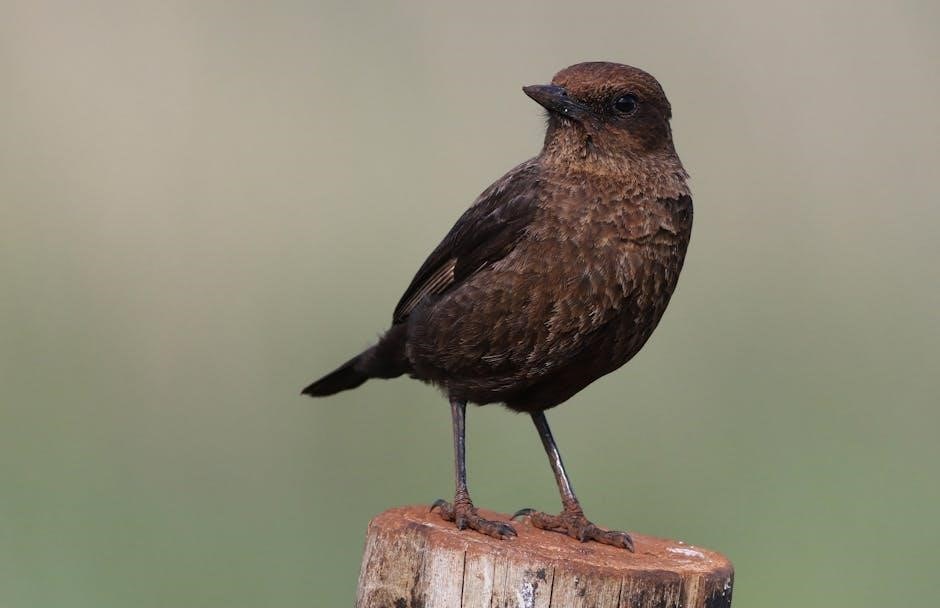
Resources for Further Reading
The Mincing Mockingbird Guide to Troubled Birds is a key resource․ Explore recommended books, online communities, and professional organizations for deeper insights into avian behavior and psychology․
Recommended Books on Bird Behavior
The Mincing Mockingbird Guide to Troubled Birds is a standout resource for understanding avian behavior․ This humorous, illustrated pocket field guide explores the darker side of bird behavior, focusing on psychotic, violent, or mentally unstable species․ Written in non-technical language, it provides vivid descriptions and witty vignettes, making it accessible to both enthusiasts and laymen․ The guide includes tales of murder, assault, and quirky behaviors, offering a unique perspective on bird psychology․ With its compact format and eye-catching visuals, it’s a must-have for anyone fascinated by the unconventional aspects of bird life․ It’s also a great gift for bird lovers with a dark sense of humor․
Online Communities for Bird Enthusiasts
Online communities dedicated to bird enthusiasts offer a wealth of knowledge and shared experiences about troubled birds․ Platforms like forums, social media groups, and specialized websites provide spaces for discussing unusual avian behaviors․ These communities often feature discussions about psychotic, violent, or mentally unstable bird species, as highlighted in guides like The Mincing Mockingbird Guide to Troubled Birds․ Members share stories, memes, and insights, creating a lively exchange of ideas․ Many groups also host expert Q&A sessions, offering practical advice on identifying and interacting with disturbed birds․ These online spaces are invaluable for those seeking to deepen their understanding of avian behavior and connect with like-minded individuals․
Professional Organizations for Bird Care
Professional organizations play a crucial role in supporting bird enthusiasts and caregivers․ Groups like VitalSource and specialized avian associations provide resources and expertise for identifying and managing troubled birds․ These organizations often collaborate with ornithologists and wildlife experts to offer comprehensive guides, workshops, and online forums․ They emphasize ethical bird care practices and provide access to scientific research on avian behavior․ By joining these organizations, enthusiasts gain valuable insights and tools to better understand and address the needs of disturbed or mentally unstable birds․ Their efforts foster a community dedicated to promoting avian welfare and education, making them indispensable for anyone serious about bird care and conservation․